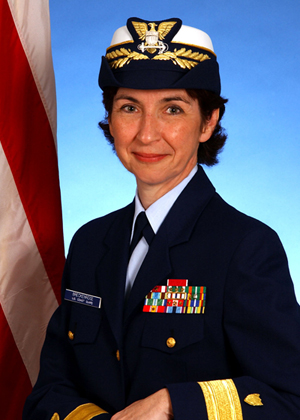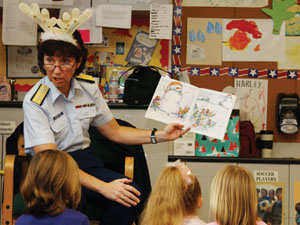|
 The changing of the guard The changing of the guard
by Juliet Crichton
|
When U.S. Coast Guard Rear Adm. Jody A. Breckenridge (biology '75) was a student at Virginia Tech, the times, well, they were a-changin'.
On campus, the emergent face of the student body--which had grown to include some 4,000 women by 1972--was perhaps most telling, but campus "culture" was visibly evolving as well. In 1973, for instance, the Virginia Tech Corps of Cadets began accepting females into its ranks; and in 1974, the first female class president was elected, and the university welcomed its first black female faculty members.
Breckenridge, who was raised in Potomac, Md., remembers that although Tech wasn't her first choice, "when I visited campus and talked to the students, I was sold on it."
And to good results. "I didn't realize what an insular life I'd led until I went to Tech," she adds. "I credit the university a great deal for my professional and social development, for my learning to understand people and be open to those of different backgrounds and experiences."
Climbing aboard
Deeply interested in her work with graduate students examining fossil fuels' impact on the environment, Breckenridge sought employment in environmental studies after graduation but discovered few opportunities beyond those in academe. Undeterred, she explored possibilities with the U.S. Navy, hoping to join one of its oceanographic labs. Learning that the labs were in a hiring freeze, she turned to the Coast Guard, at that time an agency of the Department of Transportation.
|
XX |

 Rear Adm. Jody A. Breckenridge '75 Rear Adm. Jody A. Breckenridge '75
xxphoto courtesy of U.S. Coast Guard
|
|
In the 1970s, as John A. Tillie tells it, "the armed forces were adjusting to several important national phenomena: civil rights legislation, the end of the Vietnam War, and the women's movement." For its part, the Coast Guard, no longer recognizing its Women's Reserve as a separate entity, was integrating women into active duty and admitting them into its officer candidate program, the first U.S. armed service to do so.
Concurrently, the country's escalating concern with the environment's well-being not only had prompted passage of the Federal Water Pollution Act of 1972, but had spurred the Coast Guard to initiate the Marine Environmental Protection program and to offer a multitude of operational opportunities for women.
Timing, as they say, is everything. Breckenridge entered Officer Candidate School and was commissioned in the U.S. Coast Guard in 1976.
From coast to coast
In keeping with her environmental interests, Breckenridge's first tour of duty was with the National Response Center, the country's official point of contact for reporting oil and chemical spills. After two years, she joined the Pollution Response Branch of the Marine Environmental Protection Division at Coast Guard Headquarters in Washington, D.C., where national policies for spills on the country's navigable waters were developed.
While at headquarters, Breckenridge also served the Carter administration as a social aide, a member of the military presence that facilitates events and welcomes attendees at White House functions. One especially notable occasion during Breckenridge's tenure was the 1979 signing of the Middle East Peace Accord by Egyptian President Anwar al-Sadat and Israeli Prime Minister Menachem Begin.
Following a three-year tour in Seattle as a port safety officer and then a group operations officer, Breckenridge was named assistant chief of operations at the Pay and Personnel Center in Topeka, Kan. Her husband, Paul, graduated from veterinary school while there and today practices with the Marin County Humane Society in Novato, Calif.
|
|

 Breckenridge reads a Christmas story to children at the Maintenance and Logistics Command Pacific's Child Development Center in Alameda, Calif. (U.S. Coast Guard photo by Petty Officer Brian N. Leshak) Breckenridge reads a Christmas story to children at the Maintenance and Logistics Command Pacific's Child Development Center in Alameda, Calif. (U.S. Coast Guard photo by Petty Officer Brian N. Leshak)
|
XXX
|
Subsequent tours took Breckenridge back East where, promoted to lieutenant commander, she was assistant chief/chief of the Officer Personnel Management Division and chief of officer assignments at the Coast Guard Personnel Command. She was then appointed chief of the Officer Candidate School at Training Center Yorktown, Va. Completing another tour in Seattle, this time as the executive officer of Integrated Support Command, Breckenridge returned to the Personnel Command, where she made captain and represented the Coast Guard on a special Department of Defense study, "The Officer Personnel Structure for the 21st Century." Surveying all five services, the study made 35 recommendations, most of which were eventually implemented.
Soon after, Breckenridge was named commanding officer of the Coast Guard Recruiting Command, which, following the Sept. 11 terrorist attacks, reported a significant rise in inquiries. In fact, some 4,000 people have joined the ranks of the Coast Guard since Sept. 11, making it the lead federal agency for maritime homeland security.
|
|
Breckenridge was then moved to Ballston, Va., to serve as the Coast Guard's deputy chief of staff, the tour during which she was promoted to rear admiral, one of only a handful of woman at Flag rank in the Coast Guard.
In May 2003, Rear Adm. Breckenridge was named commander of the 1,800-member Maintenance and Logistics Command Pacific in Alameda, Calif. The command, which has since partially relocated to Oakland, provides operational support to 19 major cutters and hundreds of smaller boats and Coast Guard stations across the Pacific region.
Breckenridge's latest assignment, assumed March 31, is commander of Coast Guard District Eleven on the West Coast. The re-establishment of the district, which adds some 250 new positions, is evidence of the Coast Guard's continued growth in both size and capacity since its move to the Department of Homeland Security, created in 2002.
Smooth sailing
Amidst her cross-country tours, Breckenridge earned a master of public policy from the University of Maryland--graduating with a 4.0 GPA--as well as an M.S. in national resource strategy from the Industrial College of the Armed Forces at Fort McNair in Washington, D.C.
And on the home front, the admiral and her husband have four children--the oldest of whom, a first lieutenant, has been deployed to Iraq with the 101st Air Assault from Fort Campbell, Ky., and the youngest of whom is a high school freshman.
In all aspects of her life, Breckenridge has made commitments that have brought considerable returns, even during her college years. "I'm a much better person today because of my time at Virginia Tech,” she says. “I received a very good education, and I learned discipline and how to balance responsibilities."
So it seems. The recipient of the Legion of Merit, the Meritorious Service Medal, and four Coast Guard Commendation Medals, Breckenridge, along with the Coast Guard, has grown with the times.
|
|
Headquartered in Washington, D.C., and charged with protecting U.S. waterways, the U.S. Coast Guard, with a budget of more than $5 billion, is comprised of nearly 40,000 men and women on active duty. For more information about the Coast Guard, go to www.uscg.mil.
|
|

